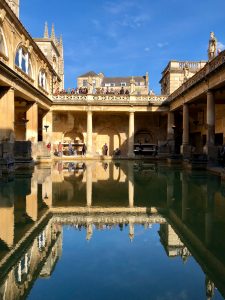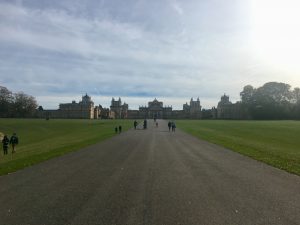Author: Emma Hecht
Location: England, United Kingdom
Pronouns: She/Her/Hers
Three weekends ago, six other Valpo students and I loaded ourselves into a van with our director, Dr. Brugh, and her husband, and took a trip to Stratford-upon-Avon and Bath. When we arrived in Stratford, we ate dinner at the Dirty Duck and afterwards, as Stratford is Shakespeare’s hometown, went to a play. Our group split up, half of us going to Tamburlaine and the other half to Maydays, a choice we had made a few days previous after reading a synopsis of each half. I was in the Maydays half because I knew it was contemporary (I did not want to sit through two hours of Shakespearian speech) and for some reason (a delusion) I thought it was going to be funny. It wasn’t funny. It was extremely political, there was a ton of yelling, and through that ton of yelling, a ton of spit spray. Thankfully, we were not in the front row.
The next day we walked around Stratford, touring Shakespeare’s childhood home and walking through an outdoor market. Mid-afternoon we all piled back into the van and headed for Bath, the home of the Roman baths. As I understand it, the baths were where old rich men could come and bathe together… The baths are still filled with water; however, no one is bathing there now, unless they want to be submerged in a sticky brown and green pool.

A Roman Bath
Two weekends ago, on a beautiful fall day, all of us gathered up again and made a trip to Blenheim Palace and Coventry Cathedral. Blenheim Palace was the home of Winston Churchill’s grandparents, where he would have lived as a toddler. For proof of this, they’ve mounted locks of his five-year-old hair above a bed in one of the rooms. However, it’s not only Churchill that stems from Blenheim Palace, but also Princess Diana Spencer. While she never lived there, the palace is still in her family.

Blenheim Palace

Blenheim Palace Grounds
Coventry Cathedral was our other stop. In preparation for the trip, we learned about the architecture of the Cathedral. It was bombed, obliterated during World War II. The walls of the original church are still somewhat intact with a little bit of the original stained glass, but there is no roof, so the area has been turned into a courtyard. Mid-twentieth century, the contemporary space was built, connected to the courtyard. The architect who designed and build this church was in close communication with the man who designed the Chapel of the Resurrection at Valpo. Some things are extremely similar, such as the paneled walls leading up to the altar. The chairs are exactly like the ones in the Chapel (although, rumor has it that the seats in the Chapel were widened three inches to accommodate Americans’ “size difference”). But instead of a stained glass window at the front, there is a huge tapestry that covers the entire wall. I still like Valpo’s Chapel better (nothing beats the stained glass window), but it was interesting to see a beautiful contemporary church in England, which seems dominated by Gothic architecture.

Coventry Cathedral Courtyard
Leave a Reply